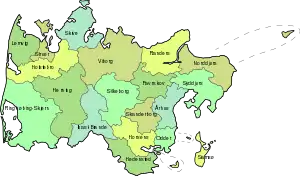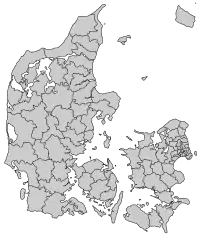Odder Municipality
Odder Municipality is a municipality (Danish: kommune) in the Central Denmark Region on the east coast of the Jutland peninsula in Central Denmark south of Aarhus. It is a part of the greater Aarhus area. The municipality covers an area of 225.04 km², including the islands of Alrø and Tunø. It borders Aarhus Municipality to the north, Skanderborg Municipality to the north-west and Horsens Municipality to the west. It also connects to Hedensted Municipality across Horsens Fjord to the south, and connects to Samsø Municipality through a ferry route.
Odder Municipality
Odder Kommune | |
|---|---|
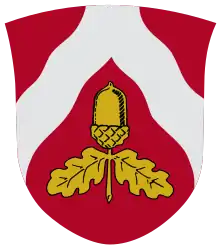 Coat of arms | |
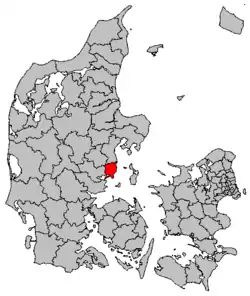 | |
| Country | |
| Region | |
| Established | April 1, 1970 |
| Seat | Odder |
| Government | |
| • Mayor | Uffe Jensen (V) |
| Area | |
| • Total | 225 km2 (87 sq mi) |
| Population (2020) | |
| • Total | 22,844 |
| • Density | 100/km2 (260/sq mi) |
| Time zone | UTC1 (CET) |
| • Summer (DST) | UTC2 (CEST) |
| Municipal code | 727 |
| Website | Odder.dk |
Odder Municipality was not merged with any adjacent municipality under the municipal reform of 2007.
The municipality includes the inhabited islands of Alrø and Tunø, as well as the uninhabited islands of Pollerne, Søby Rev and Hov Røn.
History
Odder is first mentioned in 1363. In the middle ages, Odder was not a municipality but instead a Hundred called Hads Hundred. Denmark has historically been divided into syssels in the middle ages, and Hads Hundred was part of Løversyssel. After the Reformation Hads Hundred was placed under the Aarhusgaard Fief. It became a fief of its own in 1548, with the fief's capital set at the Åkær Manor. Hads Hundred was part of Skanderborg Fief from 1597-1650, after which it turned into Åkær County in 1660. That county was dissolved after a year, and Hads Hundred was put under Skanderborg County. It came under Aarhus County in 1799. [1] The two parish municipalities of Torrild and Odder were merged in 1965. In the 1970 Danish Municipal Reform, the following parish municipalities were merged to form the current Odder Municipality: Alrø, Gosmer-Halling, Gylling, Hundslund, Saksild-Nølev, Odder, Randlev-Bjerager, Torrild, Ørting-Falling and Tunø. The 2007 municipal reform did not change anything for Odder Municipality. [2] Historical divisions
MayorsSince the 1970 municipal reform, the mayors of Odder Municipality have been:
TownsBelow are all settlements in the municipality with populations of at least 200 people (populations as of 2020).[3]
Odder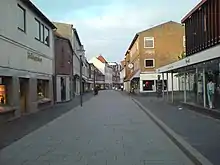 Pedestrian street in Odder. Odder is located centrally in the northern part of the municipality. It borders the forests of Dyrehave, Vejlskov and Præstelund to the south, and the forests of Bøgebjerg and Balle Skov to the north-west. It is surrounded by fields in all other directions. Odder is the administrative center of the municipality, and the location of the municipality's town hall. The eastern edge of the town is bordered by the botanical garden and zoo known as The Ecological Garden (Danish: Den Økologiske Have). South of that are a series of schools and the Grundtvigianism church Odder Grundtvigske Valgmenighedskirke. Further west, but still south of Odder River (Danish: Odder Å) is Odder Station and Odder Church. The culture center Pakhuset is located near the train station. The road Rosengade is a pedestrian street with many shops, restaurants and facilities. Odder Rådhus is located north of the street. Odder Museum is located further west, bordering Odder River. North of the river, and along the western part of the town are residential areas. The northern parts of the town include a sizable industrial quarter. [4] Near the center of the town is a sports facility called Spektrum Odder. It includes three sports halls, swimming pools, football stadiums and a café. [5] HouHou (also spelled Hov) is located 10 km south-east of Odder. It borders Kattegat to the south and east, and the narrow strait of Hov Løb between the town and the island of Hov Røn. The forest of Halling Skov borders Hou to the south-west. Hou is other than that surrounded by fields. In Hou is a marina and harbour, with daily ferry departures to Samsø and Tunø. The marina is a popular tourist destination. [6] Villages Street in Tunø By. There are two settlements on the island of Tunø: the main village of Tunø By and the smaller settlement of Løkkegårde. Tunø is a popular tourist destination. [7] There are three settlements on Alrø: Alrø By, Sønderby and Løkken. A dam from 1929 connects Alrø to the mainland. Alrø Church is located in Alrø By.[8] 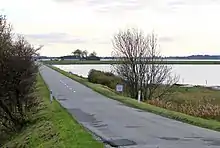 The dam connecting Alrø to the mainland. Rude Strand is located north of Hou and east of Odder. The Rude Strand Tumulus (Danish: Rude Strand Langhøj) is located here. Norsminde Fjord, north-west of Odder, cuts the village of Norsminde in two, with the northern part of the village located in Aarhus Municipality and the southern part in Odder Municipality. The northern part is called Norsminde, while the southern part is called Kysing Næs or Norsminde Strand. The ruins of Kysing Church is located in Kysing Næs. In addition to these villages, there are a number of smaller settlements in the municipality. These are all the settlements with populations of less than 200 people:[9]
NatureOdder Municipality is home to many forests, and its coastal location on Kattegat make it home to a long coastline with many breeding sites for birds. A hilly area west of Hou has been protected since 1959. Another 368 acres south of Odder has been protected since 1979. [10] Near the center of the town of Odder is a protected nature area known as Stampmølledalen, home to a forest and the brook Stampmøllebækken. It has been protected since 2000, to ensure free access to nature for the citizens of Odder, as well as to preserve the area home to the common kingfisher, a rare species in Denmark. The white-throated dipper can also be found in Stampmølledalen during the winter.[11] 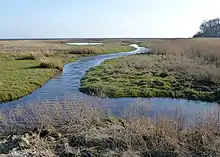 Beach meadows on Gyllingnæs. 18 acres of coast on the peninsula of Gyllingnæs has been protected since 1985. The area is known as Horskær and is home to many birds, including several of the birds of prey found in Denmark, such as common kestrel, common buzzard and western marsh harrier.[12] The northern coast along Horsens Fjord, by Vorsø and Alrø, has been protected in five stages. In Odder Municipality, the protected area include Uldrup Bakker, Sondrup Plantage, Åkær Å, Hestehave, Bavnhøj, Skablund Skov and the surrounding areas. The total protected area, across both Odder and Horsens Municipality span 2,100 acres.[13] Søby Rev are a series of small islands and islet located in Kattegat south of Hou. They span 7,5 acres. The vegetation consist mainly of grass and leymus arenarius. [14] There are a series of smaller islands and islets in the municipality. A number of small uninhabited islands and islets, known as Pollerne, are located east of Alrø. [15] Norsminde Fjord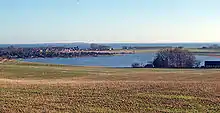 Norsminde Fjord. Norsminde Fjord borders the municipality to the north-east, and 50 acres in Odder Municipality has been protected since 1970. The fjord is an important area for birds, and has a varied surrounding nature that includes hills and beach meadows. The fjord itself span 187 acres. The fjord is home to a large amount of birds, though is not used for breeding by any birds. It is rich in food, so it is a popular foraging spot for coot, wigeon, mallard, tufted duck, teal, mute swan, lapwing, golden plover, dunlin and oystercatcher. The white-tailed eagle, and a series of other birds of prey, can be found in the area. The western marsh harrier is one of the few birds that breed in the fjord. In total, more than 200 species of birds has been registered seen in the fjord.[16] The dykes along the fjord are mainly covered in crataegus. The vegetation in the fjord itself is dominated by ulva lactuca, which can at times block out the sun for other plants in the water. The ulva lactuca is very resistant, and is a sign of pollution from the surrounding agriculture. [17] Hou RønHou Røn is an island of 2 acres located 2 km south-east of Hou. The island first appeared in the 1930s, and has at times been entirely flooded or split into several islands. It grew together to form the current island over time, and is today covered in vegetation. The island is a breeding spot for many birds, including common eider, mallard, oystercatcher, great black-backed gull, European herring gull and red-breasted merganser. At one point rats had invaded the island, but they were removed from the island again by a local hunter. Hunting on the island is forbidden while birds are breeding. [18] AlrøAlrø is a flat island, with the highest point of the island being only 14 meters above sea level. With many parts of the island lying below sea level, the island can at times be split into two. The island span 8 km², and most of the land is used for agriculture. This also means that there is barely any forests, though roe deer and several other mammals still live on the island. The European hare thrive on the island's fields. The raccoon dog is also found on the island. The greylag goose and white-tailed eagle breed on the island, and great cormorant is also commonly seen. [19][20] Tunø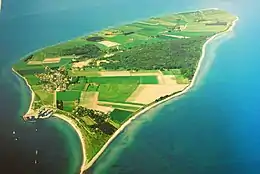 Tunø. Nearly the entire island of Tunø has been protected since 1965. The protected area amounts to 3.5 km² or 348 acres in total, and only excludes Tunø By and a small part of the harbour. The island is hilly, with forests, bogs and stony beaches. A valley splits the island in two, and it has historically been two separate islands. The valley is today covered in forests. [21][22] There aren't many birds on the island, though with the notable exception of the black guillemot. The island is home to one of Denmark's largest populations of black guillemot, a rare bird in Denmark. The other birds on the island are eurasian woodcock, western marsh harrier, common pheasant, grey partridge and common gull. The European green toad can be found on the island, and the nearby island of Samsø is the northernmost habitat for the frog in Europe. The mammals on the island are few, with only roe deer, European hare, European hedgehog, harbor seal, mice and rats. The harbour porpoise can be seen off the island's coast. The common blue butterfly is found on Tunø, though is rare in the rest of Denmark.[23] The Tunø Knob Offshore Wind Farm is located off the coast of Tunø. PoliticsThe municipality is part of Business Region Aarhus and of the East Jutland metropolitan area, which had a total population of 1.378 million in 2016.[24] Odder municipality was not merged with other municipalities as part of the extensive Municipal Reform of 2007. The mayor has since 2014 been Uffe Jensen of Venstre.[25] Municipal councilOdder's municipal council consists of 19 members, elected every four years. Below are the municipal councils elected since 1989.
EconomyThe largest industries in Odder Municipality are healthcare, education, retail, construction and food services. [26] Companies with their headquarter in Odder Municipality include a stroller factory called Oddervognen. The company has existed since 1925, and is the only stroller factory remaining in Denmark. [27] ProTruck is a company that sell forklifts and similar specialized vehicles, and is also located in Odder. [28] DemographicsThere are 22,844 people living in Odder Municipality (2020). 49.27% are men and 50.73% are women.[29] Below is the age distribution of the municipality. Age 0-5 (5.99%) 6-17 (15.07%) 18-35 (16.45%) 36-64 (39.00%) 64+ (23.49%)
EducationThere are 7 ground schools, 4 efterskoler and 3 independent schools in the municipality. There are also 3 gymnasiums, 4 folk high schools and 1 youth school in the municipality. One of the ground schools, Vestskolen, is split into two department: Skovbakken and Vestermarken. [30][31] There are 2 libraries in the municipality: one in Odder and one on Tunø. [32] TransportThe Odder Line is a former railroad, today a light rail, connecting Aarhus and Odder. It originally also connected Odder and Hou, but that stretch was shut down in 1977. The rail was renovated and turned into a light rail in 2008. [33] There are three ferry routes from Odder Municipality. Cykelfærgen connects Alrø and the town of Snaptun in Hedensted Municipality. Samsøfærgen connects Hou and the town of Sælvig on Samsø. Tunøfærgen connects Hou and Tunø. [34] Sights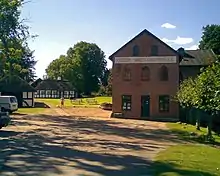 Odder Museum in the water- and steam mill. The sights of the municipality are mostly found in the town of Odder, though with churches found in many smaller towns and villages across the municipality.
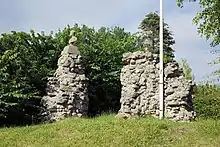 Kysing Church ruins.
Castles and manors
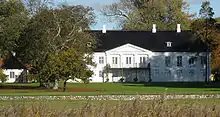 Gyllingnæs Manor.
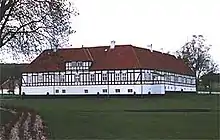 Aakær Manor.
ChurchesEventsHou Harbour Festival (Danish: Hou Havnefestival) takes place in Hou every year in the second weekend of July. The festival take place around Hou Harbour, and includes food, live music, sport and entertainment. The sport events include swimming contests in the harbour.[47][48] Sondrup Market is a yearly flea market. It takes place the first saturday in July in Hundslund. In addition to the flea market, Sondrup Market also has live music and entertainment. The organization responsible for the market also arranges other smaller markets in Hundslund across the year.[49] A yearly music festival takes place on Tunø. It has been held yearly since 1987.[50] Parishes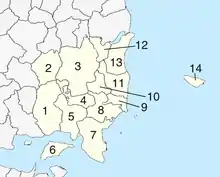 Parishes of Odder Municipality. There are 14 parishes in Odder Municipality. Shown in the table below are the populations of each parish, as well as the percentage of that population that are members of the Church of Denmark. All numbers are from 1 January 2020.
Symbols Coat of arms of Odder Municipality. The coat of arms of Odder Municipality is a slightly modified version of the town of Odder's coat of arms. It features a golden oak twig with two leaves and an acorn on red background. Two white wavy lines cross the coat of arms and come together at the top. The white lines represent the rivers surrounding Odder. The coat of arms was adopted in 2009.[65] Notable residentsPublic thought and politics
Art
Sport
External links
References
| ||||||||||||||||||||||||||||||||||||||||||||||||||||||||||||||||||||||||||||||||||||||||||||||||||||||||||||||||||||||||||||||||||||||||||||||||||||||||||||||||||||||||||||||||||||||||||||||||||||||||||||||||||||||||||||||||||||||||||||||||||||||||||||||||||||||||||||||||||||||||||||||||||||||||||||||||||||||||||||||||||||||||||||||||||||||||||||||||||||||||||||||||||||||||||||||||||||||||||||||||||||||||||||||||||||||||||||||||||||||||||||||||||||||||||||||||||||||||||||||||||||||||||||||||||||||||||||||||||||||||||||||||||||||||||||||||||||||||||||||||||||||||||||||||||||||||||||||||||||||||||||||||||||
